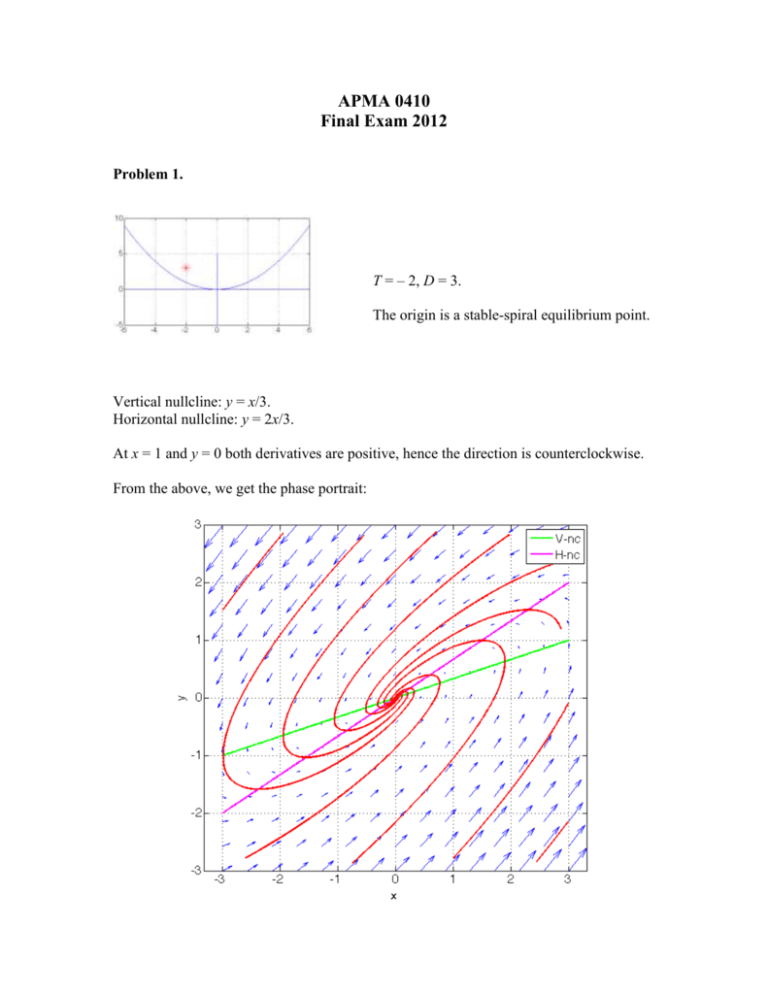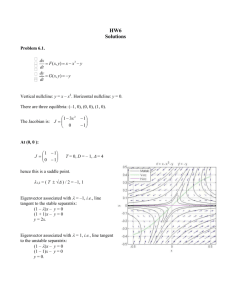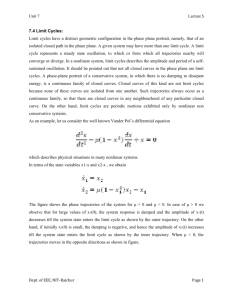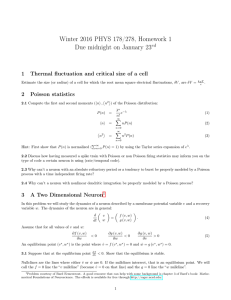final_2012_solutions
advertisement

APMA 0410 Final Exam 2012 Problem 1. T = – 2, D = 3. The origin is a stable-spiral equilibrium point. Vertical nullcline: y = x/3. Horizontal nullcline: y = 2x/3. At x = 1 and y = 0 both derivatives are positive, hence the direction is counterclockwise. From the above, we get the phase portrait: Problem 2. T = 3, D = 2. The origin is an unstable node. Vertical nullcline: y = – x. Horizontal nullcline: y = 0. Eigenvalues: 1 and 2. Eigenvector associated with eigenvalue 1 (slow eigendirection): Eigenvector associated with eigenvalue 2 (fast eigendirection): (1, 0) (1, 1) At the origin, trajectories are tangent to the slow eigendirection, i.e., to the x-axis. As time goes to +, they become parallel to the fast eigendirection, i.e., to (1, 1). Hence the phase portrait: From the eigenvalue-eigenvector analysis, we know that the general solution is: 𝑥(𝑡) = 𝑎𝑒 𝑡 + 𝑏𝑒 2𝑡 𝑦(𝑡) = 𝑏𝑒 2𝑡 , where a and b are arbitrary parameters. Solving for a and b given that x(0) = 2 and y(0) = 1, we find that a = 1 and b = 1. Thus: 𝑥(𝑡) = 𝑒 𝑡 + 𝑒 2𝑡 𝑦(𝑡) = 𝑒 2𝑡 . Therefore, at t = ln(2) we get: x=2+4=6 y = 4. Problem 3. We use separation of variables: 𝑑𝑥⁄𝑥 3 = 𝑑𝑡, hence −1⁄2𝑥 2 = 𝑡 + 𝐶, or 𝑥 = ±√−1⁄2(𝑡 + 𝐶), where 𝐶 is an arbitrary parameter. Solving for 𝐶 given that x(0) = 1, we find that 𝐶 = −0.5 and that we have to use the + sign. Thus: 𝑥(𝑡) = √1⁄(1 − 2𝑡). 𝑥(𝑡) is defined over the interval (−∞, 0.5), since 1 − 2𝑡 has to be strictly positive for the expression √1⁄(1 − 2𝑡) to be defined. The solution explodes, i.e., goes to +∞, as t approaches 0.5. Problem 4. This is an inhomogeneous linear first-order differential equation. Its general solution is the sum of a particular solution and the general solution of the corresponding homogeneous differential equation, 𝑑𝑉 ⁄𝑑𝑡 = −2𝑉, namely 𝑉(𝑡) = 𝐶𝑒 −2𝑡 . To find a particular solution of the inhomogeneous equation, we use the method of undetermined coefficients, a.k.a. judicious guessing. Here, judicious guessing means trying a function of the form 𝑎𝑡𝑒 −𝑡 + 𝑏𝑒 −𝑡 + 𝑐, since the derivative of tet includes tet as well as et. To solve for a, b and c, we plug 𝑎𝑡𝑒 −𝑡 + 𝑏𝑒 −𝑡 + 𝑐 into the equation 𝑉′ = −2𝑉 + 𝑡𝑒 −𝑡 . We find: 𝑎 = 1, 𝑏 = −1, 𝑐 = 0. Thus, the general solution of the inhomogeneous differential equation is: 𝑉(𝑡) = 𝑡𝑒 −𝑡 − 𝑒 −𝑡 + 𝐶𝑒 −2𝑡 , where 𝐶 is an arbitrary constant. To solve for 𝐶, we plug in the initial condition V(0) = 1. We get 𝐶 = 2. Thus, the solution is: 𝑉(𝑡) = 𝑡𝑒 −𝑡 − 𝑒 −𝑡 + 2𝑒 −2𝑡 . At time t = 1, we get: 𝑉(1) = 2𝑒 −2. Problem 5. Vertical nullcline: the parabola of equation 𝑥 = 𝑦 2 − 2. Horizontal nullcline: the parabola of equation 𝑥 = −𝑦 2. Equilibrium points: (–1, –1) and (–1, 1). Linearization shows that (–1, –1) is a saddle and (–1, 1) a stable clockwise spiral. Hence the phase portrait: The shape of the separatrices can be inferred through simple geometric reasoning. The separatrices are drawn in red in the diagram. We can reason that the “upper” unstable separatrix out of the saddle point spirals around the point attractor as t goes to +. The lower unstable separatrix out of the saddle goes to (+,–), like all trajectories in that region. We can also reason that the left stable separatrix into the saddle stays close to the lower branch of the horizontal nullcline as t –. The right stable separatrix into the saddle bends upwards, crosses the vertical nullcline, and goes to (–,+) as t goes to –, like all trajectories in that region. There also is an “upper” separatrix into the spiral point, which separates, as t –, the trajectories that cross the upper branch of the horizontal nullcline and go to (–,–) along the lower branch of the nullcline, from those that remain above the nullcline and go to (–,+). This separatrix hugs the upper branch of the parabola as t –. As t goes to +, trajectories go either to the point attractor (–1, 1), or to (+,–). There also are two trajectories, the stable separatrices, that go to the saddle point. As t goes to –, trajectories go either to (–,+), or to (–,–) along the separatrix that hugs the lower branch of the horizontal nullcline. There also are two trajectories, the unstable separatrices, that go to the saddle point as t goes to –. The basin of attraction of the point attractor (–1, 1) is the parabolic-shaped region above and to the left of the stable separatrices into the saddle. The basin of attraction of (+,–) is the rest of the plane. To gain some information about the slopes of trajectories, we remark that, at any point that is far from both nullclines, the term y2 dominates in both derivatives. As a result, we see that, at any point (x, y) that is far from both nullclines, the ratio of the derivatives y’/x’, hence the slope of the trajectory at (x, y), is nearly 1 in absolute value. Thus, far from the nullclines, trajectories are nearly parallel to the line y = – x or to the line y = x. This allows us to draw the following “global picture”: Bonus Problem. Vertical nullclines: the lines of equation 𝑦 = ±𝑥. Horizontal nullcline: the circle of equation 𝑥 2 + 𝑦 2 = 2. Equilibrium points: (–1, –1), (–1, 1), (1, –1), (1, 1). Linearization shows that (–1, 1) and (1, –1) are saddles, that (–1, –1) is an unstable anticlockwise spiral, and that (1, 1) is a stable clockwise spiral. Again, the separatrices can be inferred from simple geometric reasoning. Hence the phase portrait: As t goes to +, trajectories go either to the point attractor (1, 1), or to (+,–). There also are four trajectories, the stable separatrices, that go to either of the two saddle points. As t goes to –, trajectories go either to (–,+), or to the unstable spiral (–1, –1). There also are four trajectories, the unstable separatrices, that go to either of the two saddle points as t goes to –. The separatrices are drawn in red. We see that they divide the plane into four unbounded regions, which we can identify as North, West, South and East, and one bounded, roughly rectangular region in the middle, connecting the four equilibria. The basin of attraction of the point attractor (1, 1) is the union of the North region with the middle rectangular region. The basin of attraction of (+,–) is the rest of the plane.











